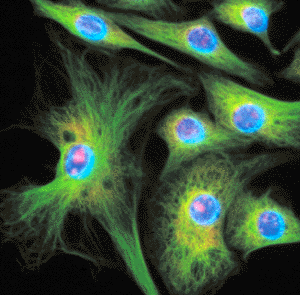
| MadSci Network: Cell Biology |
Nathan,
Good
question! The most important thing to consider with your question is
perspective – who’s doing the movement? Indeed, cells require mitochondria
to generate
the energy needed to move themselves around or perform complex motions like
peristalsis. The simple fact is that organelles don’t have sources of
energy to
move themselves about – but the cells can move them around. Organelles are
best
viewed as structural components of the cell, like an elevator in a
building;
they aren’t mini-cells within the cells (although one could argue this
about
mitochondria – but that’s a whole different story!)
Your
specific questions about exactly how an organelle moves or how a protein
gets
through the ER and Golgi are two functionally different processes. They
fall
under the rubric of two processes: organelle movement and protein
trafficking. I’m
not sure if you want the nit-gritty details, but they are below if you want
them!
First, organelle movement. I’ll consider big things like mitochondria or other membranous bodies. As I mentioned before, organelles don’t have their own source of energy. They utilize the ATP generated in the mitochondria to get around. But to really understand how the organelles move, we need to probe a bit deeper to ask, How are they using that energy?

|
You started to get at this with
one of your questions – the one about whether a chemical attraction does
the
work. And of course, the annoying, scientist’s answer is always: yes,
kinda.
The organelles need to have something to move around on – they just can’t
propel themselves around the cytoplasm. There exists an elaborate, internal
structural network throughout the entire cell – not unlike the girders that
support a building. (picture to the left, from Molecular
Probes) This "cytoskeleton" is the surface that organelles can move on. Among
the
proteins that make up the cytoskeleton, microtubules are the predominant
"walkway" organelles use to move around the cell. Specialized ‘motor
proteins’
are attached to both the organelle and the microtubules (via chemical
interactions). These proteins, called kinesins (which generally move
towards
the periphery) and dyneins (which move towards the center) ‘walk’ the
organelle
up and down the microtubules. It’s these motor proteins that utilize ATP to
move around, and drag the organelle with it. (Follow
this
link for a moving cartoon illustrating how kinesin might
"walk"
on a microtubule)
|
Cells use both of these processes to get a lot done, and even use variations on the themes to achieve novel, complex behaviors. For example, the release of neurotransmitter at the synapse requires protein synthesis and transport of those proteins to the axon terminal (the ending which releases transmitter – it’s usually a good distance away from the cell body). Neurotransmitter is also stored in vesicles at the terminal, and these vesicles have SNAREs to mediate the fusion with the cell membrane – the event which causes transmitter release. But these aren’t your average, ordinary SNAREs – they are specially designed to release neurotransmitter ONLY when the right signal comes along (as opposed to the Golgi system, in which any vesicle with the right SNARE will fuse as soon as it finds the right target).
I hope this of some use! I got most of this info from the Bible of molecular biology, The Molecular Biology of the Cell, by Bruce Alberts and Co. (3rd edition, 1994, Garland Publishing)
Alex G
cgoddard@fas.harvard.edu
A primer on cytoskeleton can be found at http://www.biology.arizona.edu/cell_bio/tutorials/cytoskeleton/main.ht ml